You’re in a meeting, offering a game-changing idea. The data is solid, the benefits are clear. But instead of openness, you’re met with resistance.
"That won’t work here."
"We’ve always done it this way."
Sound familiar?
Now, be honest—have you ever caught yourself doing the same thing?
Maybe you read an article, attend a training, or hear a perspective that challenges what you’ve always believed. For a moment, something clicks.
"This makes sense. I should change."
But then… you don’t.
Days pass, and before you know it, you're back to your old ways.
Why?
The truth is, we don’t just resist change because we’re stubborn. We resist because new ideas threaten our existing beliefs—and our brains instinctively protect us from that discomfort.
The Four Ways We Defend Our Existing Beliefs
When faced with contradictory evidence, we unconsciously engage in cognitive defense mechanisms—without even realizing it.
1️⃣ Ignoring
Skipping past an article, research, or conversation that challenges us. (Not today, not my problem.)
2️⃣ Rationalizing
"That might work for them, but not for me."
3️⃣ Cherry-Picking Evidence
Gravitating toward proof that supports what we already believe while dismissing inconvenient facts. (Ever Googled something just to confirm you were right?)
4️⃣ Shifting the Goalposts
If proven wrong, subtly tweaking our stance just enough to keep our belief intact.
Example: Someone firmly believes, “Good teachers don’t need scripted curriculum.” But when shown research proving that structured programs significantly help new teachers, they adjust:
"Well, that’s just for beginners, not experienced teachers like me.”
That’s shifting the goalposts in action.
The Hidden Risk of Surface-Level Change
This is why so many attempts at change fail.
People go through the motions, but they never actually shift their mindset. They comply on the surface—following the new system, strategy, or approach—but still hold onto their old belief.
The moment stress hits, they revert back to their old ways.
Let’s say we’re trying to get a teacher to run a more student-centered classroom. If they don’t first unlearn the belief that “teaching equals telling,” they might technically follow the new model while still controlling every discussion, limiting student voice.
The belief didn’t change—so the behavior never really did either.
Why Real Change Requires Unlearning First
Psychologist Kurt Lewin’s Change Model explains that transformation happens in three stages:
1️⃣ Unfreeze – Let go of existing beliefs and assumptions.
2️⃣ Change – Actively adopt new ways of thinking and behaving.
3️⃣ Refreeze – Reinforce the new mindset until it becomes habit.
Most people skip the unfreezing step. That’s why new habits don’t stick.
Without unlearning first, change remains surface-level. People outwardly comply but internally resist, leading to frustration and regression.
Why I Started the Bra Challenge (And What It Taught Me About Unlearning)
A few days ago, I started what I jokingly called the bra challenge.
On the surface, it was simple: replace my old, worn-out bras with ones that actually fit, looked good, and met a higher standard than the ones I had been settling for.
But it wasn’t really about bras.
It was about unlearning—unlearning my own standards for myself, my relationship with money, time, and even what I believed I deserved.
For years, I operated from a mindset of functional, done, there.
If something worked, why replace it?
If it got the job done, why spend time or money upgrading?
If I could tolerate it, why demand more?
But one day, standing in front of the mirror, adjusting the same stretched-out, worn-thin bra I’d been wearing for years, I felt a flash of irritation.
Not at the bra. At myself.
Why was I still doing this?
Why was I choosing discomfort when I didn’t have to?
And in that moment, I realized: this wasn’t about clothing. This was about how I had learned to settle.
✅ Settle for convenience.
✅ Settle for survival.
✅ Settle for whatever was “fine” instead of what was right for me.
So, I made the decision: I would raise the bar.
Or, in this case—the bra.
Why Change Requires Unlearning First
I could have just gone out and bought new bras.
That would have been a surface-level change.
But to actually follow through, I had to unpack and unlearn the beliefs holding me back:
❌ The belief that spending money on myself is wasteful.
❌ The belief that comfort and quality are luxuries, not essentials.
❌ The belief that investing in myself—whether in clothing, self-care, or growth—is indulgent instead of necessary.
It was never about bras.
It was about challenging what I had accepted as “enough” for myself.
What This Has to Do With Real Change
We all have our own version of this.
The things we ignore, put off, or settle for—not because we don’t know better, but because our beliefs keep us from acting.
That’s why unlearning comes first.
We don’t just resist change because it’s hard—we resist it because it asks us to let go of the beliefs that make us feel safe.
Your Turn: What’s Your “Bra Challenge” Moment?
What’s one small thing in your life you’ve been tolerating for too long?
A belief, a habit, an old version of yourself?
What’s one step you can take today to unlearn it?
Maybe it’s your job, your leadership, your relationships, or how you see yourself.
Maybe it’s as small as replacing something worn-out, or as big as redefining what success means to you.







